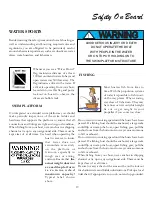
8
Chapter 2
PYROTECHNIC DEVICES
Pyrotechnic visual distress signals must be Coast Guard
approved, be ready for service and must be readily
accessible. They all display a marking which is the service
life, which must not have expired. A minimum of 3
devices are required for the day and 3 devices for night.
Some devices meet both day and night requirements.
Pyrotechnic devices should be stored in a cool, dry
location. Most of these devices can be purchased in an
highly visible (orange) watertight container. Types of
Coast Guard approved pyrotechnic distress signals and
associated devices are:
Pyrotechnic red flares, hand-held or aerial type.
Pyrotechnic orange smoke, hand-held or floating type.
Launchers for parachute flares or aerial red meteors.
All in all, each distress signal has certain advantages and
disadvantages.
There is no distress signal that is best under all situations.
Pyrotechnics are recognized world-wide as superior
distress signals. A downfall is they emit a very hot flame
that can cause burns and or ignite flammable materials.
Pistol launched and hand-held parachute flares operate
consistant with firearms and therefore must be carefully
handled. Check with local and state regulations since since
some of these devices are considered firearms and are
prohibited.
Non-pyrotechnic devices must all be in serviceable
condition, readily accessible, and must be certified by the
manufacturer to comply with Coast Guard standards. They
include:
Orange distress flag.
Electric distress flag.
The distress flag is for day use only. It must be 3 x 3 or
larger with a black square and ball on an orange
background. It can be spotted when attached to a boat
hook, long fishing rod, or paddle with the person waving
the flag back and forth overhead.
The electric distress flag is for night use only flashing the
international SOS distress signal (..._ _ _ ...).
Under Inland Navigation Rules, a high intensity white light
that flashes at regular intervals from 50-70 times per minute
is considered a distress signal.
Remember that regulations prohibit the display of visual
distress signals on the water under any circumstances
except when assistance is required to prevent immediate
or potential danger to passengers on a vessel.
NON-PYROTECHNIC DEVICES
Summary of Contents for 30 EXPRESS
Page 1: ...30 EXPRESS OWNER S MANUAL...
Page 2: ...784022 OWNER S MANUAL 30 EXPRESS 12 2012...
Page 30: ...11 Safety On Board NAVIGATION LIGHT RULES...
Page 41: ...Chapter 2 22 Notes...
Page 44: ...3 Rules Of The Road NAVIGATION RULES...
Page 85: ...28 Chapter 5 Notes...
Page 105: ...4 Chapter 7...
Page 106: ...5 Equipment Operation...
Page 107: ...6 Chapter 7...
Page 108: ...7 Equipment Operation...
Page 109: ...8 Chapter 7...
Page 110: ...9 Equipment Operation...
Page 111: ...10 Chapter 7...
Page 117: ...16 Chapter 7...
Page 126: ...25 Equipment Operation ROTARY ENCODER AND MENU KEY...
Page 127: ...26 Chapter 7 USING THE ROTARY ENCODER AND MENU KEY...
Page 158: ...57 Equipment Operation BACKING A TRAILER 1 2 3 4 LAUNCHING RAMP...
Page 161: ...60 Chapter 7 Notes...
Page 195: ...34 Chapter 8 Notes...
Page 204: ...9 Troubleshooting TOILET SYSTEM DIAGNOSTIC CHART...
Page 209: ...14 Chapter 9...
Page 219: ...6 Chapter 11 Notes...
Page 221: ...2 Chapter 12...
Page 224: ...5 Technical Information 30 Express Deck Overview 30 Express Cabin Overview...
Page 225: ...Technical Information 12 6 30 EXPRESS...
Page 226: ...12 7 Technical Information 30 EXPRESS...
Page 227: ...Technical Information 12 8 30 EXPRESS...
Page 228: ...12 9 Technical Information 30 EXPRESS...
Page 229: ...Technical Information 12 10 30 EXPRESS 30 EXPRESS...
Page 230: ...12 11 Technical Information TYPICAL NEGATIVE GROUND SYSTEM...
Page 231: ...Technical Information 12 12 30 EXPRESS...
Page 232: ...12 13 Technical Information 30 EXPRESS...
















































